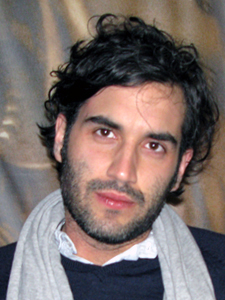'Version' Online Arts Journal to Experiment with Content, Viral Publishing
March 20, 2009 / By Tiffany Fox, (858) 246-0353, tfox@ucsd.edu
San Diego, Calif., March 20, 2009 — A new online journal based at the University of California, San Diego, is experimenting with Web 2.0 sensibilities to explore the space where art, viral publishing and multitasking collide.
|
Titled Version, the journal features short-form writing, photography, video and other media work limited to 500 words, five images or 50 seconds in length. Co-editor Jordan Crandall, an associate professor in UC San Diego's Department of Visual Arts, says the publishing constraints are intended, in part, to accommodate an increasingly crowded online world, where content must compete for the attention of users who are already bombarded by constant media feeds and the demands of social networking.
"The idea behind Version is to avoid publishing long academic essays that require a substantial investment of time," Crandall explains. "Instead, we're interested in work that you can read in conjunction with the other things you're doing on the Internet. In this way, Version lends itself to a kind of multitasking space, where the content stays agile, mobile and re-mixable."
The public is invited to celebrate the launch of Version at a reception from 5 to 7 p.m. Thursday, April 2, at the gallery@Calit2, located in Atkinson Hall on the UCSD campus. The reception will include a presentation on the history and development of Version. Calit2, otherwise known as the California Institute for Telecommunications and Information Technology, is producing the journal in conjunction with UCSD's Visual Arts Department and its Division of Arts and Humanities.
Although the journal's content will initially be published within the confines of the Version Web site, co-editor Caleb Waldorf imagines it will spread by way of 'viral publishing' — a means of sharing content among users until it ultimately lives in a multitude of spaces online.
"We purposely designed our content modules to be the same size as the advertising blocks you see on most Web sites so that they can reside anywhere on the Web," says Waldorf, who is a Los Angeles-based artist, former UCSD Visual Arts graduate student and researcher with the Center for Research in Computing and the Arts at Calit2. "The way we title the content is flexible enough that it can be recognizable in other places, almost like a code string."
A Version essay about the deadpan humor of conceptual artist John Baldessari, for example, is titled "Illuminations.john+c+welchman.deadpan.022609," reflecting the journal content category ("illuminations") the author (UCSD's John Welchman, professor of modern art history), the title of the piece ("deadpan") and the date of publication. When displayed in a Twitter feed or as a Deli.cio.us bookmark, the titling mechanism serves as a marker of Version's brand identity, but is also understandable to users who have never visited the Version Web site.
|
"Eventually," Crandall predicts, 'Version could become a decentralized journal. We hope our identity will carry through as the content gets forwarded and resides in other places, but perhaps it will mutate, and maybe that's interesting, too."
While the majority of the journal's initial contributors are faculty and affiliates of the Visual Arts Department, Crandall and Waldorf say they are especially interested in transcending disciplines and genre divides and welcome contributions from anyone up to the challenge.
"Our idea is to publish work that is based in anecdote and allegory: Stories, scenes and encounters that happen in everyday life, things we can all relate to," Crandall says. "Although there is a certain experimental element behind this project, it's not a grand philosophical argument. It's about the texture and richness of physical experience. It's about that sensory charge you get when something resonates with you.
"With good art, you want to pay attention to the infrastructure and form, yes, but also the content. And in order for this journal to work, the content has to be compelling, evocative, rich and full of life."
Related Links
Version
gallery@Calit2
UCSD Department of Visual Arts
UCSD Division of Arts and Humanities
Media Contacts
Tiffany Fox, (858) 246-0353, tfox@ucsd.edu



